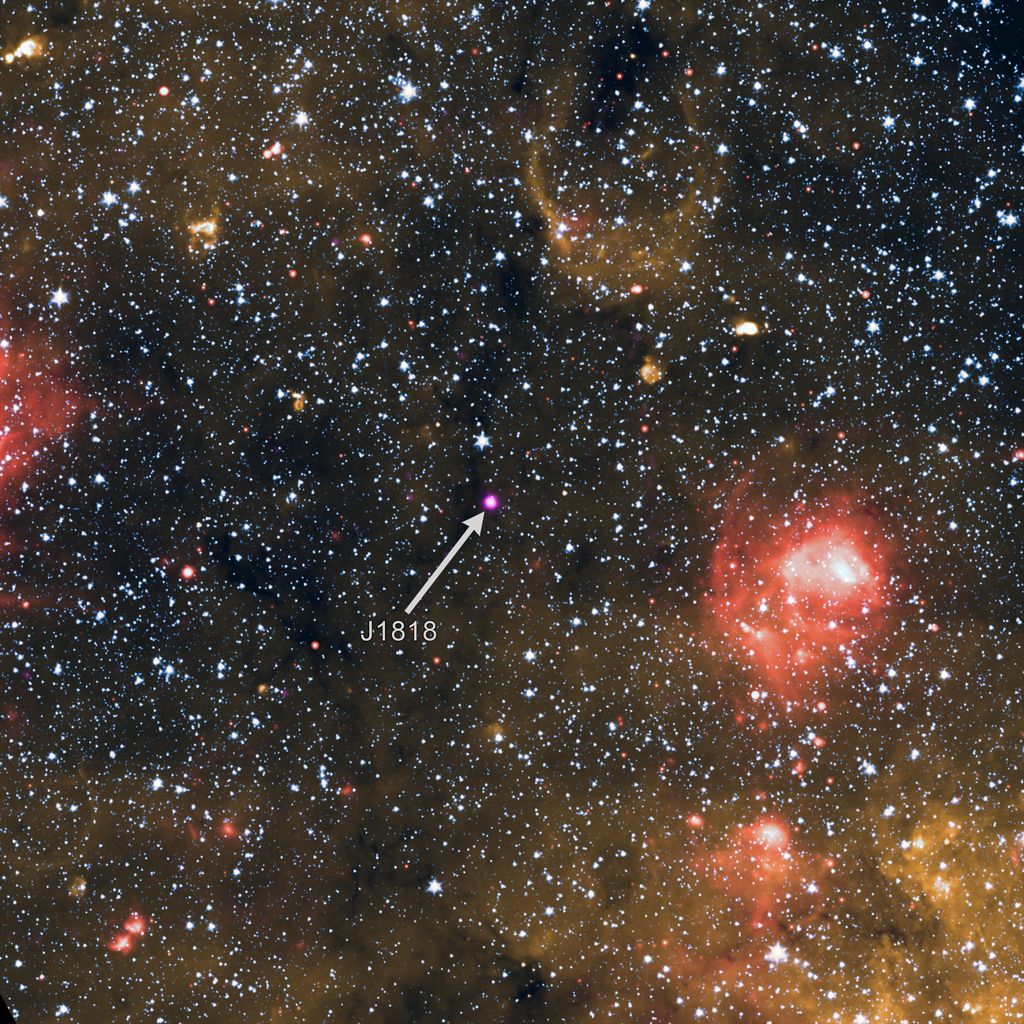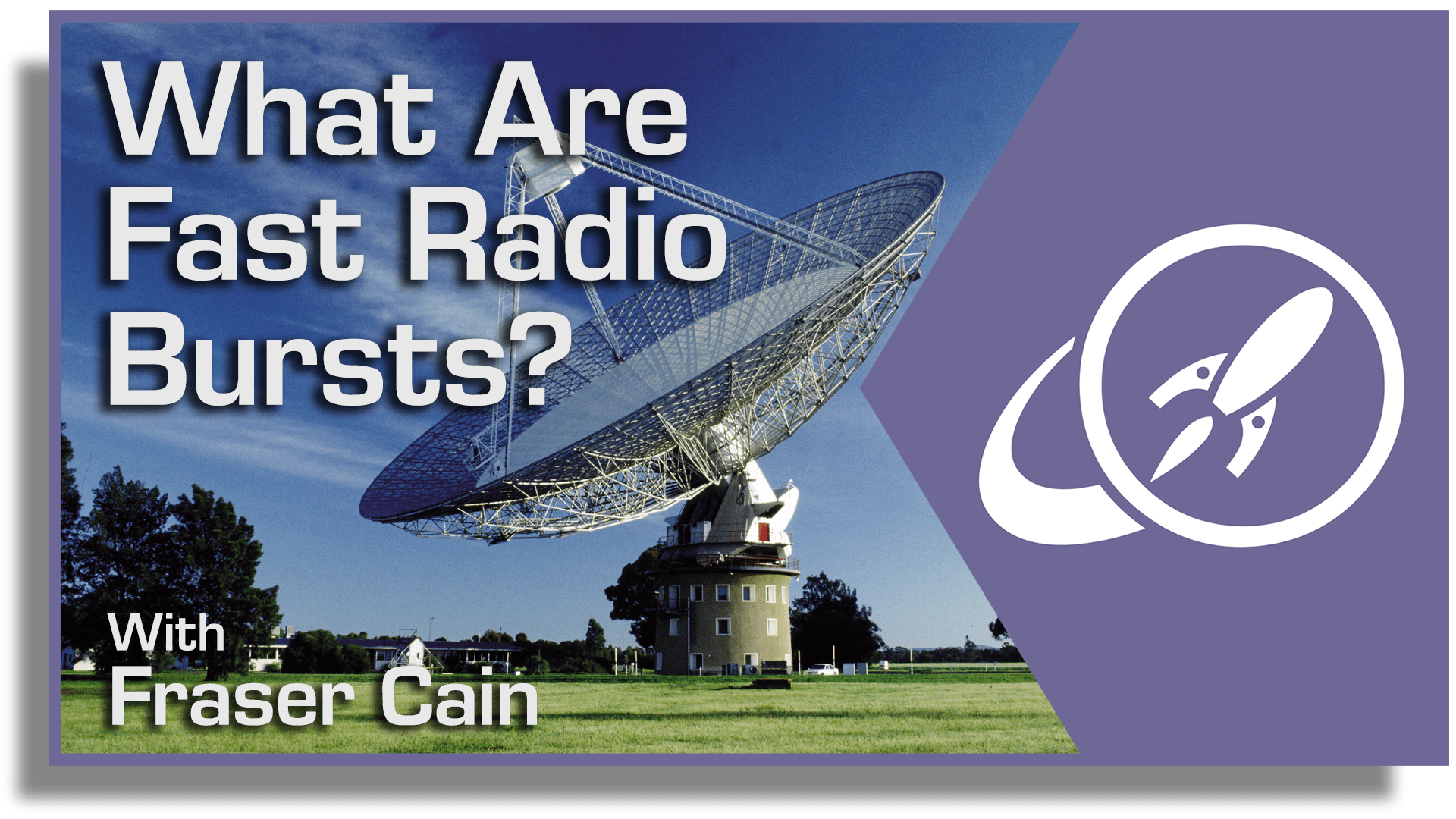Some of the most stunningly powerful objects in the sky aren’t necessarily the prettiest to look at. But their secrets can allow humanity to glimpse some of the more intricate details of the universe that are exposed in their extreme environs. Any time we find one of these unique objects it’s a cause for celebration, and recently astronomers have found an extremely unique object that is both a magnetar and a pulsar, making it one of only 5 ever found.
Continue reading “Only 31 Magnetars Have Ever Been Discovered. This one is Extra Strange. It’s Also a Pulsar”Pulsars Confirm One of Einstein’s Best Ideas, That Freefall Really Feels Like You’re Experiencing a Lack of Gravity

Six and a half decades after he passed away, famed theoretical physicist Albert Einstein is still being proven right! In addition to General Relativity (GR) being tested under the most extreme conditions, lesser-known aspects of his theories are still being validated as well. For example, GR predicts that gravity and inertia are often indistinguishable, in what is known as the gravitational Strong Equivalence Principle (SEP).
Thanks to an international team of researchers, it has been proven under the strongest conditions to date. By precisely tracking the motion of a pulsar, the team demonstrated that gravity causes neutron stars and white dwarf stars to fall with equal accelerations. This confirms Einstein’s prediction that freefall accurately simulates zero-gravity conditions in all inertial reference frames.
Continue reading “Pulsars Confirm One of Einstein’s Best Ideas, That Freefall Really Feels Like You’re Experiencing a Lack of Gravity”Astronomers Map the Surface of a Pulsar
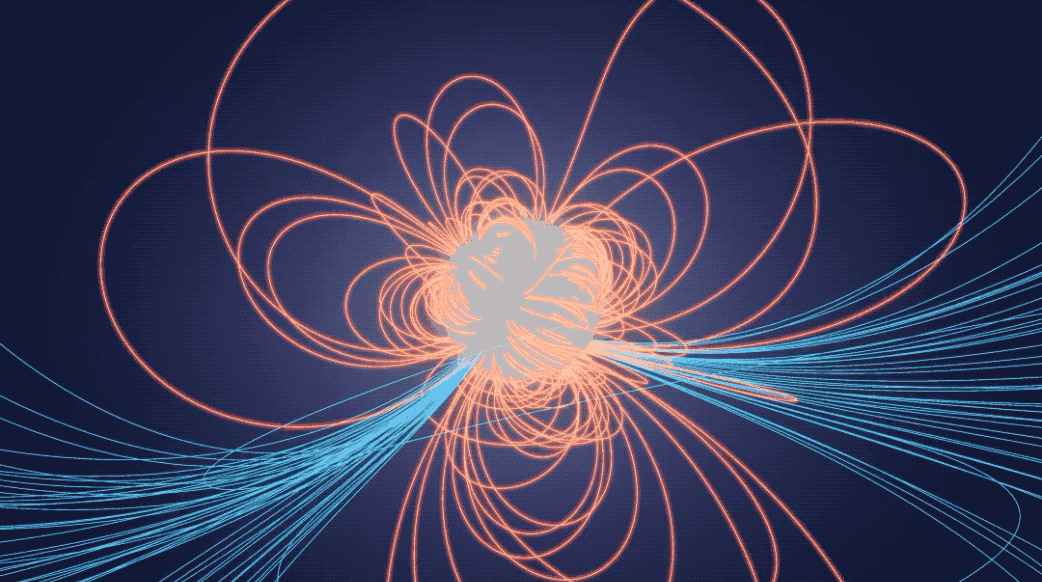
When stars exhaust their supply of fuel, they collapse under their own weight and explode, blowing off their outer layers in an event known as a “supernova”. In some cases, these events leave behind neutron stars, the smallest and densest of stellar objects (with the exception of certain theoretical stars) that sometimes spin rapidly. Pulsars, a class of neutron star, can spin up to several hundred times per second.
One such object, designated J0030+0451 (J0030), is located about 1,100 light-years from Earth in the Pisces constellation. Recently, scientists using NASA’s Neutron star Interior Composition Explorer (NICER) were able to measure the pulsar’s size and mass. In the process, they also managed to locate the various “hot spots” on its surface, effectively creating the first map of a neutron star.
Continue reading “Astronomers Map the Surface of a Pulsar”Pulsar Seen Speeding Away From the Supernova That Created it

When a star exhausts its nuclear fuel towards the end of its lifespan, it undergoes gravitational collapse and sheds its outer layers. This results in a magnificent explosion known as a supernova, which can lead to the creation of a black hole, a pulsar or a white dwarf. And despite decades of observation and research, there is still much scientists don’t know about this phenomena.
Luckily, ongoing observations and improved instruments are leading to all kinds of discoveries that offer chances for new insights. For instance, a team of astronomers with the National Radio Astronomy Observatory (NRAO) and NASA recently observed a “cannonball” pulsar speeding away from the supernova that is believed to have created it. This find is already providing insights into how pulsars can pick up speed from a supernova.
Continue reading “Pulsar Seen Speeding Away From the Supernova That Created it”Carnival of Space #583
Welcome to the 583rd Carnival of Space! The Carnival is a community of space science and astronomy writers and bloggers, who submit their best work each week for your benefit. We have a fantastic roundup today so now, on to this week’s worth of stories!
Continue reading “Carnival of Space #583”
An Aging Pulsar has Captured a new Companion, and it’s Spinning back up Again
When massive stars reach the end of their life cycle, they explode in a massive supernova and cast off most of their material. What’s left is a “milliscond pulsar”, a super dense, highly-magnetized neutron star that spins rapidly and emit beams of electromagnetic radiation. Eventually, these stars lose their rotational energy and begin to slow down, but they can speed up again with the help of a companion.
According to a recent study, an international team of scientists witnessed this rare event when observing an ultra-slow pulsar located in the neighboring Andromeda Galaxy (XB091D). The results of their study indicated that this pulsar has been speeding up for the past one million years, which is likely the result of a captured a companion that has since been restoring its rapid rotational velocity.
Typically, when a pulsars pairs with an ordinary star, the result is a binary system consisting of a pulsar and a white dwarf. This occurs after the pulsar pulls off the outer layers of a star, turning it into a white dwarf. The material from these outer layer then forms an accretion disk around the pulsar, which creates a “hot spot” that radiates brightly in the X-ray specturum and where temperatures can reach into the millions of degrees.
The team was led by Ivan Zolotukhin of the Sternberg Astronomical Institute at Lomonosov Moscow State University (MSU), and included astronomers from the University of Toulouse, the National Institute for Astrophysics (INAF), and the Smithsonian Astrophysical Observatory. The study results were published in The Astrophysical Journal under the title “The Slowest Spinning X-Ray Pulsar in an Extragalactic Globular Cluster“.
As they state in their paper, the detection of this pulsar was made possible thanks to data collected by the XMM-Newton space observatory from 2000-2013. In this time, XMM-Newton has gathered information on approximately 50 billion X-ray photons, which has been combined by astronomers at Lomosov MSU into an open online database.
This database has allowed astronomers to take a closer look at many previously-discovered objects. This includes XB091D, a pulsar with a period of seconds (aka. a “second pulsar”) located in one of the oldest globular star clusters in the Andromeda galaxy. However, finding the X-ray photos that would allow them to characterize XB091D was no easy task. As Ivan Zolotukhin explained in a MSU press release:
“The detectors on XMM-Newton detect only one photon from this pulsar every five seconds. Therefore, the search for pulsars among the extensive XMM-Newton data can be compared to the search for a needle in a haystack. In fact, for this discovery we had to create completely new mathematical tools that allowed us to search and extract the periodic signal. Theoretically, there are many applications for this method, including those outside astronomy.”
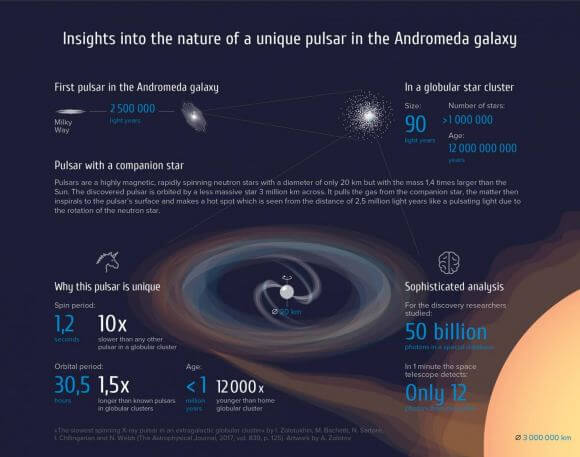
Based on a total of 38 XMM-Newton observations, the team concluded that this pulsar (which was the only known pulsar of its kind beyond our galaxy at the time), is in the earliest stages of “rejuvenation”. In short, their observations indicated that the pulsar began accelerating less than 1 million years ago. This conclusion was based on the fact that XB091D is the slowest rotating globular cluster pulsar discovered to date.
The neutron star completes one revolution in 1.2 seconds, which is more than 10 times slower than the previous record holder. From the data they observed, they were also able to characterize the environment around XB091D. For example, they found that the pulsar and its binary pair are located in an extremely dense globular cluster (B091D) in the Andromeda Galaxy – about 2.5 million light years away.
This cluster is estimated to be 12 billion years old and contains millions of old, faint stars. It’s companion, meanwhile, is a 0.8 solar mass star, and the binary system itself has a rotation period of 30.5 hours. And in about 50,000 years, they estimate, the pulsar will accelerate sufficiently to once again have a rotational period measured in the milliseconds – i.e. a millisecond pulsar.
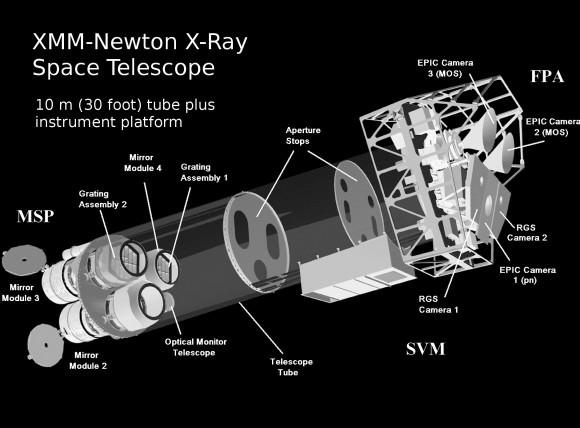
Interestingly, XB910D’s location within this vast region of super-high density stars is what allowed it to capture a companion about 1 million years ago and commence the process “rejuvenation” in the first place. As Zolotukhin explained:
“In our galaxy, no such slow X-ray pulsars are observed in 150 known globular clusters, because their cores are not big and dense enough to form close binary stars at a sufficiently high rate. This indicates that the B091D cluster core, with an extremely dense composition of stars in the XB091D, is much larger than that of the usual cluster. So we are dealing with a large and rather rare object—with a dense remnant of a small galaxy that the Andromeda galaxy once devoured. The density of the stars here, in a region that is about 2.5 light years across, is about 10 million times higher than in the vicinity of the Sun.”
Thanks to this study, and the mathematical tools the team developed to find it, astronomers will likely be able to revisit many previously-discovered objects in the coming years. Within these massive data sets, there could be many examples of rare astronomical events, just waiting to be witnessed and properly characterized.
Further reading: The Astrophysical Journal, Lomonosov Moscow State University
What Are Fast Radio Bursts?
You might think you’re reading an educational website, where I explain fascinating concepts in space and astronomy, but that’s not really what’s going on here.
What’s actually happening is that you’re tagging along as I learn more and more about new and cool things happening in the Universe. I dig into them like a badger hiding a cow carcass, and we all get to enjoy the cache of knowledge I uncover.
Okay, that analogy got a little weird. Anyway, my point is. Squirrel!
Fast radio bursts are the new cosmic whatzits confusing and baffling astronomers, and now we get to take a front seat and watch them move through all stages of process of discovery.
Stage 1: A strange new anomaly is discovered that doesn’t fit any current model of the cosmos. For example, strange Boyajian’s Star. You know, that star that probably doesn’t have an alien megastructure orbiting around it, but astronomers can’t rule that out just yet?
Stage 2: Astronomers struggle to find other examples of this thing. They pitch ideas for new missions and scientific instruments. No idea is too crazy, until it’s proven to be too crazy. Examples include dark matter, dark energy, and that idea that we’re living in a
Stage 3: Astronomers develop a model for the thing, find evidence that matches their predictions, and vast majority of the astronomical community comes to a consensus on what this thing is. Like quasars and gamma ray bursts. YouTuber’s make their videos. Textbooks are updated. Balance is restored.
Today we’re going to talk about Fast Radio Bursts. They just moved from Stage 1 to Stage 2. Let’s dig in.
Fast radio bursts, or FRBs, or “Furbys” were first detected in 2007 by the astronomer Duncan Lorimer from West Virginia University.
He was looking through an archive of pulsar observations. Pulsars, of course, are newly formed neutron stars, the remnants left over from supernova explosions. They spin rapidly, blasting out twin beams of radiation. Some can spin hundreds of times a second, so precisely you could set your watch to them.

In this data, Lorimer made a “that’s funny” observation, when he noticed one blast of radio waves that squealed for 5 milliseconds and then it was gone. It didn’t match any other observation or prediction of what should be out there, so astronomers set out to find more of them.
Over the last 10 years, astronomers have found about 25 more examples of Fast Radio Bursts. Each one only lasts a few milliseconds, and then fades away forever. A one time event that can appear anywhere in the sky and only last for a couple milliseconds and never repeats is not an astronomer’s favorite target of study.
Actually, one FRB has been found to repeat, maybe.
The question, of course, is “what are they?”. And the answer, right now is, “astronomers have no idea.”
In fact, until very recently, astronomers weren’t ever certain they were coming from space at all. We’re surrounded by radio signals all the time, so a terrestrial source of fast radio bursts seems totally logical.
About a week ago, astronomers from Australia announced that FRBs are definitely coming from outside the Earth. They used the Molonglo Observatory Synthesis Telescope (or MOST) in Canberra to gather data on a large patch of sky.
Then they sifted through 1,000 terabytes of data and found just 3 fast radio bursts. Three.
Since MOST is farsighted and can’t perceive any radio signals closer than 10,000 km away, the signals had to be coming outside planet Earth. They were “extraterrestrial” in origin.
Right now, fast radio bursts are infuriating to astronomers. They don’t seem to match up with any other events we can see. They’re not the afterglow of a supernova, or tied in some way to gamma ray bursts.
In order to really figure out what’s going on, astronomers need new tools, and there’s a perfect instrument coming. Astronomers are building a new telescope called the Canadian Hydrogen Intensity Mapping Experiment (or CHIME), which is under construction near the town of Penticton in my own British Columbia.
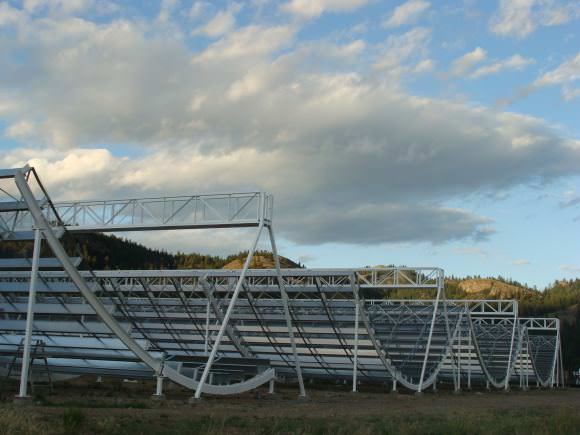
It looks like a bunch of snowboard halfpipes, and its job will be to search for hydrogen emission from distant galaxies. It’ll help us understand how the Universe was expanding between 7 and 11 billion years ago, and create a 3-dimensional map of the early cosmos.
In addition to this, it’s going to be able to detect hundreds of fast radio bursts, maybe even a dozen a day, finally giving astronomers vast pools of signals to study.
What are they? Astronomers have no idea. Seriously, if you’ve got a good suggestion, they’d be glad to hear it.
In these kinds of situations, astronomers generally assume they’re caused by exploding stars in some way. Young stars or old stars, or maybe stars colliding. But so far, none of the theoretical models match the observations.

Another idea is black holes, of course. Specifically, supermassive black holes at the hearts of distant galaxies. From time to time, a random star, planet, or blob of gas falls into the black hole. This matter piles upon the black hole’s event horizon, heats up, screams for a moment, and disappears without a trace. Not a full on quasar that shines for thousands of years, but a quick snack.
The next idea comes with the only repeating fast radio burst that’s ever been found. Astronomers looked through the data archive of the Arecibo Observatory in Puerto Rico and found a signal that had repeated at least 10 times in a year, sometimes less than a minute apart.
Since the quick blast of radiation is repeating, this rules out a one-time collision between exotic objects like neutron stars. Instead, there could be a new class of magnetars (which are already a new class of neutron stars), that can release these occasional shrieks of radio.

Or maybe this repeating object is totally different from the single events that have been discovered so far.
Here’s my favorite idea. And honestly, the one that’s the least realistic. What I’m about to say is almost certainly not what’s going on. And yet, it can’t be ruled out, and that’s good enough for my fertile imagination.
Avi Loeb and Manasvi Lingam at Harvard University said the following about FRBs:
“Fast radio bursts are exceedingly bright given their short duration and origin at distances, and we haven’t identified a possible natural source with any confidence. An artificial origin is worth contemplating and checking.”
Artificial origin. So. Aliens. Nice.
Loeb and Lingam calculated how difficult it would be to send a signal that strong, that far across the Universe. They found that you’d need to build a solar array with twice the surface area of Earth to power the radio wave transmitter.
And what would you do with a transmission of radio or microwaves that strong? You’d use it to power a spacecraft, of course. What we’re seeing here on Earth is just the momentary flash as a propulsion beam sweeps past the Solar System like a lighthouse.
But in reality, this huge solar array would be firing out a constant beam of radiation that would propel a massive starship to tremendous speeds. Like the Breakthrough Starshot spacecraft, but for million tonne spaceships.

In other words, we could be witnessing alien transportation systems, pushing spacecraft with beams of energy to other worlds.
And I know that’s probably not what’s happening. It’s not aliens. It’s never aliens. But in my mind, that’s what I’m imagining.
So, kick back and enjoy the ride. Join us as we watch astronomers struggle to understand what fast radio bursts are. As they invalidate theories, and slowly unlock one of the most thrilling mysteries in modern astronomy. And as soon as they figure it out, I’ll let you know all about it.
What do you think? Which explanation for fast radio bursts seems the most logical to you? I’d love to hear your thoughts and wild speculation in the comments.
Weekly Space Hangout – November 11, 2016: Pat Ammons of Space Camp, and Bob King of “Night Sky With The Naked Eye”
Host: Fraser Cain (@fcain)
Special Guests:
Pat Ammons is Director of Communications, U.S. Space & Rocket Center, to discuss SpaceCamp.
Bob King is a UT contributor who will be joining us to promote his new book “Night Sky with the Naked Eye.”
Guests:
Kimberly Cartier ( KimberlyCartier.org / @AstroKimCartier )
Morgan Rehnberg (MorganRehnberg.com / @MorganRehnberg)
Their stories this week:
What will Trump’s space policy look like?
Is NASA preparing to abandon Orion?
An exotic pair of stellar remnants
Subaru’s new exoplanet atmosphere instrument
We use a tool called Trello to submit and vote on stories we would like to see covered each week, and then Fraser will be selecting the stories from there. Here is the link to the Trello WSH page (http://bit.ly/WSHVote), which you can see without logging in. If you’d like to vote, just create a login and help us decide what to cover!
If you would like to join the Weekly Space Hangout Crew, visit their site here and sign up. They’re a great team who can help you join our online discussions!
If you would like to sign up for the AstronomyCast Solar Eclipse Escape, where you can meet Fraser and Pamela, plus WSH Crew and other fans, visit our site linked above and sign up!
We record the Weekly Space Hangout every Friday at 12:00 pm Pacific / 3:00 pm Eastern. You can watch us live on Universe Today, or the Universe Today YouTube page.
Can We Get Space Madness?
If you’ve watched any Ren and Stimpy cartoons, you know that one of the greatest hazards of spaceflight is “space madness”. Only exposure to the isolation and all pervasive radiation of deep space could drive an animated chihuahua into such a state of lunacy.
What will happen if they press the history eraser button? Maybe something good? Maybe something bad? I guess, we’ll never know.
Of course, Ren and Stimpy weren’t the first fictionalized account of people losing their marbles when they fly into the inky darkness of space. There were the Reavers from Firefly, that crazy Russian cosmonaut in Armageddon, almost everyone in the movie Sunshine, and it was the problem in every second episode of Star Trek.

According to movies and television, if you’ve got space madness, you and your crewmates are in for a rough ride. If you’re lucky, you merely hallucinate those familiar space sirens, begging you to take off your space helmet and join them for eternity on that asteroid over there.
But you’re just as likely to go homicidal, turning on your crewmates, killing them one by one as a dark sacrifice to the black hole that powers your ship’s stardrive. And whatever you do, don’t stare too long at that pulsar, with its hypnotic, rhythmic pulse. The isolation, the alien psycho-waves, dark whisperings from eldritch gods speak to you though the paper-thin membrane of sanity. If we go to space, does only madness await us?
If you’ve spent any time around human beings, you know that we’ve got our share of mental disease right here on Earth. You don’t have to travel to space to suffer depression, anxiety, and other mental disorders.
Once we’re in orbit, or prancing about on the surface, of Mars, we’re going to experience our share of human physical and mental frailties. We’re going to take our basic humanity to space, including our brains.
According to the National Institute of Mental Health, 18% of the US population, or 40 million Americans suffer from some variety of anxiety-related disorder. 6.7% of adults had a major, crippling depressive episode over the course of a year.
Unless we improve treatment outcomes for mental disorders here on Earth, we can expect to see similar outcomes in space. Especially once we make exploration a little safer, and we’re not concerned with our immediate exposure to the vacuum of space. But will going to space make things worse?

NASA has carried out two studies on astronaut psychological health studies. One for the cosmonauts and astronauts on the Mir space station, and a second study for the folks on the International Space Station. They tested both the folks in space as well as their ground support staff once a week, to see how they were doing.
Although they reported some tension, there was no loss in mood or group cohesion during the mission. The crews had better cohesion when they had an effective leader on board.
Isolation working in close quarters has been heavily studied here on Earth, with submarine crews and isolated groups at research bases in Antarctica.

Earlier this year, a crew of simulated Mars astronauts emerged, unharmed from a year-long isolation experiment in Hawaii. The six international crewmembers were part of the Hawaii Space Exploration Analog and Simulation experiment, to see what would happen to potential Mars explorers, stuff on the surface of the red planet for a year.
They couldn’t leave their 110 square-meter (1,200 square-foot) habitat without a spacesuit on. What did they report? Mostly boredom. Some interpersonal issues. Now that they’re out, some are good friends, and others probably won’t stay in contact, or pay too much attention to them in their Facebook feed.
The bottom line is that it doesn’t seem like there’s too much of a risk from the isolation and close quarters. Well, nothing that we’re not used to dealing with as human beings.
But there is another problem that has revealed itself, and might be much more severe: space dementia. And we’re not talking about the song from Muse.
According to researchers from the University of California, Irvine, long term exposure to the radiation of deep space will cause significant damage to our fragile human brains. Or at least, that’s what happened to a group of rats bathed in radiation at the NASA Space Radiation Laboratory at New York’s Brookhaven National Laboratory.
Over time, the damage to their brains would cause astronauts to experience a type of dementia that causes anxiety. Brain cancer patients who receive radiation treatment are prone to this as well.

During the months and years of a Mars mission, astronauts would take a large dose of radiation, even with shielding, and the effects would be harmful to their bodies and to their brains. In fact, even when the astronauts return to Earth, their condition might worsen, with more anxiety, depression, memory problems, and a loss of decision making ability. This is a serious problem that needs to be solved if humans are going to live for a long time outside the Earth’s protective magnetosphere.
It turns out, science fiction space madness isn’t a real thing, it’s a plot device like warp drives, teleporters, and light sabers.
Isolation and close proximity isn’t much of a problem, we’ve dealt with it before, and we can still work with people, even though we hate them and the way they slurp their coffee, and lean back on their chair, even though that thing is totally going to break and they’re going to hurt themselves. And they won’t stop doing it, no matter how many times we ask them to stop.
Once again, radiation in space is a big problem. It’s out there, it’s everywhere, and we don’t have a great way to protect against it. Especially when it wrecks our brains.
What Are Magnetars?
In a previous article, we crushed that idea that the Universe is perfect for life. It’s not. Almost the entire Universe is a horrible and hostile place, apart from a fraction of a mostly harmless planet in a backwater corner of the Milky Way.
While living here on Earth takes about 80 years to kill you, there are other places in the Universe at the very other end of the spectrum. Places that would kill you in a fraction of a fraction of a second. And nothing is more lethal than supernovae and remnants they leave behind: neutron stars.
We’ve done a few articles about neutron stars and their different flavours, so there should be some familiar terrain here.

As you know, neutron stars are formed when stars more massive than our Sun explode as supernovae. When these stars die, they no longer have the light pressure pushing outward to counteract the massive gravity pulling inward.
This enormous inward force is so strong that it overcomes the repulsive force that keeps atoms from collapsing. Protons and electrons are forced into the same space, becoming neutrons. The whole thing is just made of neutrons. Did the star have hydrogen, helium, carbon and iron before? That’s too bad, because now it’s all neutrons.
You get pulsars when neutron stars first form. When all that former star is compressed into a teeny tiny package. The conservation of angular motion spins the star up to tremendous velocities, sometimes hundreds of times a second.
But when neutron stars form, about one in ten does something really really strange, becoming one of the most mysterious and terrifying objects in the Universe. They become magnetars. You’ve probably heard the name, but what are they?
As I said, magnetars are neutron stars, formed from supernovae. But something unusual happens as they form, spinning up their magnetic field to an intense level. In fact, astronomers aren’t exactly sure what happens to make them so strong.

One idea is that if you get the spin, temperature and magnetic field of a neutron star into a perfect sweet spot, it sets off a dynamo mechanism that amplifies the magnetic field by a factor of a thousand.
But a more recent discovery gives a tantalizing clue for how they form. Astronomers discovered a rogue magnetar on an escape trajectory out of the Milky Way. We’ve seen stars like this, and they’re ejected when one star in a binary system detonates as a supernova. In other words, this magnetar used to be part of a binary pair.
And while they were partners, the two stars orbited one another closer than the Earth orbits the Sun. This close, they could transfer material back and forth. The larger star began to die first, puffing out and transferring material to the smaller star. This increased mass spun the smaller star up to the point that it grew larger and spewed material back at the first star.
The initially smaller star detonated as a supernova first, ejecting the other star into this escape trajectory, and then the second went off, but instead of forming a regular neutron star, all these binary interactions turned it into a magnetar. There you go, mystery maybe solved?
The strength of the magnetic field around a magnetar completely boggles the imagination. The magnetic field of the Earth’s core is about 25 gauss, and here on the surface, we experience less than half a gauss. A regular bar magnet is about 100 gauss. Just a regular neutron star has a magnetic field of a trillion gauss. Magnetars are 1,000 times more powerful than that, with a magnetic field of a quadrillion gauss.
What if you could get close to a magnetar? Well, within about 1,000 kilometers of a magnetar, the magnetic field is so strong it messes with the electrons in your atoms. You would literally be torn apart at an atomic level. Even the atoms themselves are deformed into rod-like shapes, no longer usable by your precious life’s chemistry.
But you wouldn’t notice because you’d already be dead from the intense radiation streaming from the magnetar, and all the lethal particles orbiting the star and trapped in its magnetic field.
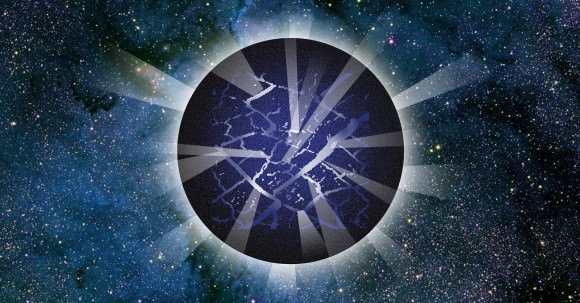
One of the most fascinating aspects of magnetars is how they can have starquakes. You know, earthquakes, but on stars… starquakes. When neutron stars form, they can have a delicious murder crust on the outside, surrounding the degenerate death matter inside. This crust of neutrons can crack, like the tectonic plates on Earth. As this happens, the magnetar releases a blast of radiation that we can see clear across the Milky Way.
In fact, the most powerful starquake ever recorded came from a magnetar called SGR 1806-20, located about 50,000 light years away. In a tenth of a second, one of these starquakes released more energy than the Sun gives off in 100,000 years. And this wasn’t even a supernova, it was merely a crack on the magnetar’s surface.
Magnetars are awesome, and provide the absolute opposite end of the spectrum for a safe and habitable Universe. Fortunately, they’re really far away and you won’t have to worry about them ever getting close.

